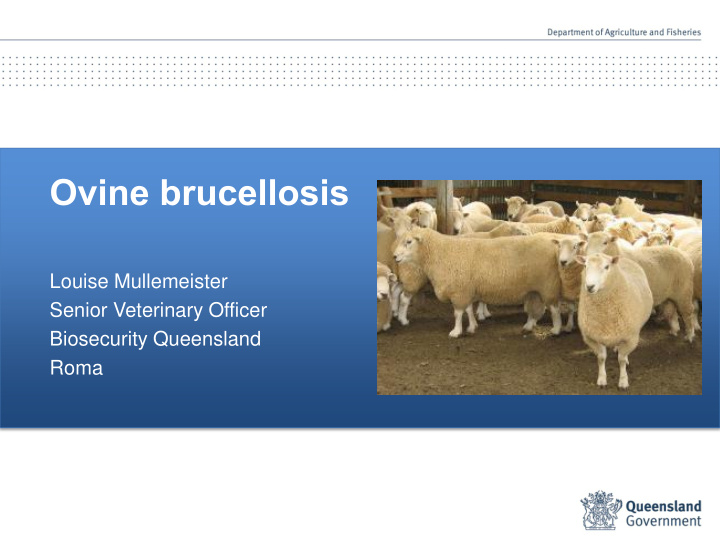



Ovine brucellosis Louise Mullemeister Senior Veterinary Officer Biosecurity Queensland Roma
Brucellosis Species Host Presence Brucella ovis Sheep Occurs in Australia Brucella suis* Pigs Occurs in Australia Brucella abortus* Cattle Exotic Brucella melitensis* Goats Exotic Brucella canis* Dogs Exotic *Potentially zoonotic
Ovine brucellosis
Economic impact • Reduced semen quality & increased ram turnover • Poor conception rates • Reduced lamb marking percentage • Extended lambing period – Pasture management & supplementation – Metabolic disorders & mismothering – Wool length & quality – Lamb weights & condition scores • Abortions (uncommon)
Transmission • Ram to ram – Indirectly via ewe • Passive venereal transmission – Directly • Sodomy • Licking prepuce • Ram to ewe (uncommon)
Reproductive anatomy
Reproductive anatomy
Symptoms
Symptoms Not all rams infected with ovine brucellosis will have palpable abnormalities. Not all palpable abnormalities are due to ovine brucellosis.
Diagnosis • Complement fixation test (CFT) • Semen culture • Post mortem & culture of reproductive organs
Control/eradication • Not a notifiable disease in Qld • No regulatory control • No enforced eradication/control program • Voluntary Ovine Brucellosis Accreditation Scheme – Flock & property biosecurity measures – Clinical examination & testing regime
Poll With regards to the Ovine Brucellosis Accreditation Scheme, who: • Has an accredited flock • Only buys rams from an accredited flock • Isn’t accredited & doesn’t buy from accredited flocks?
Control/eradication Eradication • Culling & replacing entire ram flock • Identifying, testing & culling infected animals • Combination of control & eradication programs Control • Using additional rams at joining • Manual palpation of rams prior to joining • Extending joining period • Regular turn-over of rams • Weaning prior to joining
Eradication Program considerations: • Sheep-proof fencing • Clean musters • Individual identification of rams • Prompt removal of infected rams • Avoid joining period • Consistent testing intervals • Test straying animals • Buy rams from accredited flocks/tested prior to entry Seek veterinary advice first
Prevention Flock & property biosecurity • Sheep proof fences • Livestock records • Isolation from unknown, unaccredited, infected sheep • Management of straying sheep • Source sheep from OB accredited flocks • Isolate & test introduced sheep
Questions?
Image references Slide 1: http://www.nzva.org.nz Slide 3: http://dpi.nsw.gov.au; http://australiandorper.com.au; http://www.dpi.qld.gov.au; http://www.whitesuffolk.com.au Slide 6, 7, 8 & 9: http://dpi.nsw.gov.au Slide 10 & 11: http://fao.org; http://flockandherd.net.au Slide 13: http://sheepconnectsa.com.au Slide 14: http://oie.int
Recommend
More recommend